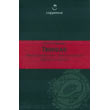 FLAVOR PROFILE: highly variable across the spectrum, divided by 3 general types: a) wood (cedar, spruce, pine) & spices (cinnamon, clove); b) grass & butter (including tobacco leaf / leather tannins, sometimes coconut); c) tropical citrus (often acidic reds like sour cherry)
FLAVOR PROFILE: highly variable across the spectrum, divided by 3 general types: a) wood (cedar, spruce, pine) & spices (cinnamon, clove); b) grass & butter (including tobacco leaf / leather tannins, sometimes coconut); c) tropical citrus (often acidic reds like sour cherry)
CHARACTERISTICS: the grand compromiser; combines strength & stamina of Amazon with some flavors & finesse of Criollo, neither durable as the former nor rarefied as the latter; intensely sought-after nonetheless, especially genuine ones from Trinidad where its polychromatic fruit pods range from yellow, green, orange & red to violet
In the popular vernacular ‘Trinitario’ is a cross between Criollo & ‘Forastero’. In actuality it’s much more complicated. And now controversial too, having been abandoned in the research…
… of Dr. Basil Bartley who spent the entire second half of the 20th century in the field, including extensive wild cacáo explorations throughout the Amazon Rainforest & other regions of the world, becoming responsible for introducing the concept of hybrid cultivars along the way. His view on the term ‘Trinitario’ is unequivocal & straightforward – do not use it, particularly in its current sense.
‘Trinitario’ originated as a specific cultivated variety (cultivar) on the island of Trinidad. Two events are seminal in its emergence: 1) a mysterious natural disaster destroyed much of the island’s Criollo in 1727. Amazon trees were brought in to crossbreed with the few surviving Criollos; 2) In 1757, Criollos in Venezuela, threatened with disease, were transplanted to the island sanctuary of Trinidad, just 5 miles off Venezuela’s east coast. These, in turn, were crossed with an Amazon from that introduction 30 years earlier that local Trinidadians called ‘Forastero Calabacillo’ or ‘foreign calabash’ (with respect to the shape & size of the fruit, as well as to its lineage originating off the island). This is perhaps when the term ‘Forastero’ was coined.
Not until another 200 years, around 1940, did the term ‘Trinitario’ begin circulating, coming into vogue as the hybrid of Criollo & ‘Forastero’ grown in Trinidad. Since then, ‘Trinitario’ has developed into a cover-all for any hybrid that’s neither too strongly Criollo nor too Amazon – a crazily confused jumble, with just about everything & anything swept under the ‘Trinitario’ rug in what Bartley describes as a “mental dust bin”.
Only Amazon-Criollo hybrids whose parentage can reasonably be traced to Trinidad should be designated ‘Trinitario’, & then more accurately labeled ‘Trinitario Complex’ to convey that it’s no variety per se but rather an admixture of many types. (Molecular markers identify 3 main progenitors in most Trinitario hybrids — a) SP1 Criollo genotype from Venezuela; b) MAT1-6, a Matina Amelonado-type from Costa Rica; & c) SIAL70 Amelonado from Seleção do Instituto Agronómico do Leste, Brazil.) And even in Trinidad different estates have vastly different subcomponents in the mix. The ones that share a common Venezuelan Criollo ancestry are called ‘Old Trinitario’ by geneticists.





